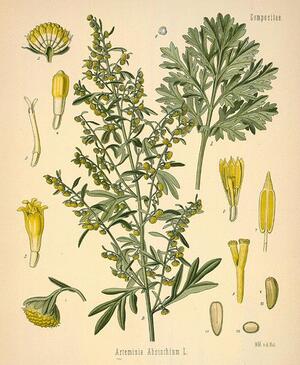Wormwood - Artemisia Absinthium
imag source: http://www.botanical.com/botanical/mgmh/w/wormwo37.html#worcom
Physical Characteristics
Artemisia absinthium (absinthium, absinthe wormwood, wormwood, common wormwood, or grand wormwood) is a species of wormwood, native to temperate regions of Eurasia and northern Africa. It is a herbaceous perennial plant, with a hard, woody rhizome.It grows naturally on uncultivated, arid ground, on rocky slopes, and at the edge of footpaths and fields. It prefers soil rich in nitrogen. The plant's characteristic odor can make it useful for making a plant spray against pests. In the practice of companion planting, because of the secretions of its roots, it exerts an inhibiting effect on the growth of surrounding plants, thus weeds. It can be useful to repel insect larvae but it need only be planted on the edge of the area of cultivation. It has also been used to repel fleas and moths indoors.http://en.wikipedia.org/wiki/Artemisia_absinthium
Edible Uses
Leaves are occasionally used as a flavouring. Caution is advised, prolonged use is known to have a detrimental effect. The plant is poisonous if used in large quantities. Even small quantities have been known to cause nervous disorders, convulsions, insomnia etc. Just the scent of the plant has been known to cause headaches and nervousness in some people. The plant contains thujone. In small quantities this acts as a brain stimulant but is toxic in excess. http://www.pfaf.org/database/plants.php?Artemisia+absinthum
Wormwood extract is the basis of the notorious and banned liquor Absinthe. http://www.feeverte.net/recipes.html
Medicinal Uses
Tonic, stomachic, febrifuge, anthelmintic.
A nervine tonic, particularly helpful against the falling sickness and for flatulence. It is a good remedy for enfeebled digestion and debility. http://www.botanical.com/botanical/mgmh/w/wormwo37.html#worcom
Myths and Tales
Artemisia comes from Ancient Greek ἀρτεμισία, from Ἄρτεμις (Artemis).In Hellenistic culture, Artemis was a goddess of the hunt, and protector of the forest and children. Absinthium comes from Ancient Greek ἀψίνθιον (apsinthion),[4] possibly meaning “unenjoyable”, and probably referring to the bitter nature of the derived beverage.The word “wormwood” comes from Middle English “wormwode” or “wermode”. The form “wormwood” is influenced by the traditional use as a cure for intestinal worms. Webster's Third New International Dictionary attributes the etymology to Old English “wermōd” (compare with German Wermut and the derived drink Vermouth). An alternate explanation dubiously combines the Old English “wer”, meaning “man” (as in “werewolf”), with OE “mōd”, meaning “mood” http://en.wikipedia.org/wiki/Artemisia_absinthium
Other Uses
Repellent; Strewing.
The fresh or dried shoots are said to repel insects and mice, they have been laid amongst clothing to repel moths and have also been used as a strewing herb. An infusion of the plant is said to discourage slugs and insects. The plant contains substances called sesquiterpene lactones, these are strongly insecticidal. http://www.pfaf.org/database/plants.php?Artemisia+absinthum

